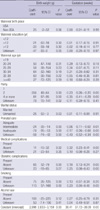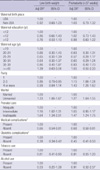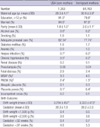INTRODUCTION
The USA Census in the year 2000 showed that there were 10,171,820 Asians, 3.61% of the USA population (
1). Among all Asians, there were 1,072,682 Koreans, 10.5% of all Asians or 0.38% of the USA population and by the size, ranked the fifth following, Chinese, Filipinos, Asian Indians, and Vietnamese. About 22.3% of these Koreans were born in the USA. The size of Korean population in the USA has significantly increased in the last several decades, considering there were only 357,393 Koreans present in the USA in the 1980. Births to Korean parents have increased in the USA reaching 12,222 births in the year 2004.
The USA National Center for Health Statistics began to report births to Korean parents, separating them out from Asian Pacific Islanders and other Asian group in 1992. Before then, it was difficult to study birth outcomes of Korean births in the USA. To the present, we are aware of only three studies on Korean birth outcomes (
2-
4). One study was limited to examining intrauterine growth retardation and prematurity by maternal nativity and not examined birth weight, or very low and low birth weight (
2). Two other studies examined births in a single state, Hawaii and California, but birth outcomes in Korean births were not examined in detail (
3,
4). None of these studies compared birth outcomes of the USA-born Korean infants to the infants born in Korea.
In Korea over the last several decades, number of foreign residents and interracial marriages, particularly between Korean man and non-Korean Asians, has gradually increased (
5). Although there have been a significant number of births from these two groups, at present their detailed birth outcomes are not known, since these births cannot be separately identifiable.
Maternal sociodemographic and biologic factors are strongly associated with pregnancy outcomes. Birth outcomes vary among different racial ethnic groups (
6) and also, by maternal nativity, native-born versus foreign-born, possibly reflecting the effects of acculturation, particularly considering potential differential social and environmental effects on birth outcomes by mother's upbringing and her current environment (
7-
16).
The objective of our study is to explore potential differences in birth outcomes in USA-born Korean infants by mother's birth place, and to compare birth outcomes of the USA-born Korean infants to infants born in Korea.
MATERIALS AND METHODS
Study population and variables
Our study used the 1995 through 2004 National Center for Health Statistics (NCHS) linked live birth and infant death certificate data files, which contain selected information on resident live births. Before 1992, NCHS classified births to Asians or Pacific Islanders into Chinese, Japanese, Hawaiian, Filipino, and other Asians or Pacific Islanders. Then, Korean births were not separately identified. In 1992, seven states with the largest Asian or Pacific Islander populations began to provide NCHS with additional birth data, reclassifying previously coded other Asians and Pacific Islanders into Asian Indian, Korean, Vietnamese, Samoan, Guamanian, and remaining other Asian or Pacific Islanders. NCHS stated that at least two-thirds of each of these additional Asian and Pacific Islander groups in the USA lived in the seven-State reporting area, California, Hawaii, Illinois, New Jersey, New York, Texas, and Washington. This reporting system was adopted by other additional states, increasing to total of 14 states by 2003. The latest available data on USA births is for the year 2005, but information on mother's birth place is not included. In the period from 1995 through 2004, NCHS reported 106,213 infants born to Korean parents, either to both Korean parents (n=67,619), or to parents at least one being either Korean mother or Korean father (n=38,594).
Part I Study-Comparison of birth outcomes, USA-births to the USA-born Korean mothers vs. USA births to the non-USA-born Korean mothers
This part of our study compares birth outcomes of live births from USA-born Korean women to those of live births from non-USA-born Korean women. For this part, we selected 66,116 singleton live births to both Korean parents by excluding 1,412 multiple births and 91 births with missing information on birth place of mother (
Fig. 1).
We examined birth outcomes of these births by birth place of mother, controlling for maternal sociodemographic and medical and obstetric status. Birth outcomes include birth weight, gestational age, very low birth weight (<1,500 g), low birth weight (<2,500 g), <32 weeks of gestation, and <37 weeks of gestation. Maternal sociodemographic variables include maternal age, educational level, marital status, alcohol use and smoking. Obstetric factors include parity, adequacy of prenatal care, and presence or absence of the following complications, preeclampsia, fetal distress, prolonged rupture of membranes, meconium-stained amniotic fluid, placental abruption, placenta previa, incompetent cervix, and genital herpes infection. Medical status includes presence or absence of the following diseases: diabetes mellitus, anemia, chronic hypertension, and renal disease.
Part II Study-Comparison of birth outcomes, USA-born Korean infants vs. infants born in Korea
This part of the study compares birth outcomes of USA-born Korean infants to those of infants born in Korea (
Fig. 1). For this comparison, all USA-born Koreans were selected, including singleton and multiple births to both Korean parents or to either Korean mother or Korean father. Korean birth cohort data included births to foreign mothers and fathers, mostly Asians. Thus, for the comparison, USA-born Korean infant group included infants born to both Korean parents and infants born to biracial Korean parents with either mother or father being Chinese, Vietnamese, Filipino, Japanese, or other Asians but not Hawaiian, Guamanian or Asian Indian and excluded white, African American, Hispanics, and American Indians. This selection was purposeful to similarly match major proportions of intermarriages in Korea. Information on birth outcomes on infants born in Korea are from the published aggregated data (
5,
17,
18). Although there have been a significant number of births from non-Korean mothers or fathers in Korea, none of these published data reported birth outcomes by maternal or paternal race.
Statistical analysis
For group comparison, we used paired t, ANOVA, and chi-square tests. To test independent effect of mother's birth place on individual birth outcomes (birth weight, low birth weight, and prematurity), we used both logistic and multiple linear regression analyses. Statistical significance was accepted when P value was <0.05. For all statistical analyses, we used a statistical software, STATA 10 (Stata Corp., College Station, TX, USA).
DISCUSSION
It has been repeatedly demonstrated that mother's sociodemographic factors are closely associated with birth outcomes. These include maternal education, age, place of birth, parity, marital status, smoking, alcohol use, prenatal care status, and medical and obstetric complications. Increased migration of Koreans to the USA over the last several decades has resulted in a sizable number of births to Koreans in the USA. We suspected that change in parental, particularly maternal environment would affect birth outcomes of their offspring. Thus, we examined birth outcomes of three groups of births, USA births to USA-born Korean mothers, USA births to non-USA-born Korean mothers, and births in Korea.
Although we have limited data, particularly on infants born in Korea, there was no evidence that among these three groups, birth outcomes were remarkably different. To begin with, there was 29 g difference in birth weight between the two USA-born Korean singleton infant groups by maternal nativity, 3,294 g for infants of the USA-born Korean mothers and 3,323 g for infants of the non-USA-born Korean mothers. This slight difference by maternal nativity was not statistically significant, once controlled for other maternal factors. Other birth outcomes namely, low birth weight and prematurity were not different by maternal nativity when whether not adjusted or adjusted for other maternal sociodemographic, medical, and obstetric factors.
We expected that birth outcome of USA-born Korean infants would differ by birth place of mother. People migrated to a foreign country would have adapted to new cultural and social environment. This acculturation process of migrants is quite complex, including educational attainment, marital status, age at and number of childbirths, health risk behaviors, and social habits such as smoking and alcohol use (
19-
22). All these acculturated parental factors would affect birth outcomes of their offspring. A large number of studies examined the acculturation effect on birth outcomes using maternal nativity as a proxy (
7-
16). The acculturation effect on birth outcomes appears to vary by race, even after adjustment of common maternal factors, namely, maternal age, parity, marital status, education and prenatal care. Black, Chinese, and Hispanic women migrated to the USA had more favorable birth outcomes in their offspring compared to the USA-born women of the same race (
7-
11). In non-Hispanic white, Japanese, and Filipino, birth outcomes did not differ by maternal nativity (
7,
11). However, USA-born Asian women had better birth outcomes in their offspring compared to the foreign-born Asian women (
11). For birth outcomes of the USA-born Korean infants, there are three previous studies (
2-
4). Mor and her associates examined birth outcomes in Hawaii in the period 1979-1989 (
3). In their study, Korean ethnicity was a risk factor for very low birth weight and birth before 33 weeks of gestation, but not for overall prematurity or low birth weight. Maternal nativity did not alter birth outcomes. Qin and Gould examined birth outcomes of six Asian sub-populations in California by maternal nativity (
4). In their study, Korean births had no difference in low birth weight and preterm outcomes by maternal nativity. However, foreign-born Korean mothers were older, had a higher parity, and less privately insured for delivery, compared to the USA-born Korean mothers. These other differences in maternal status were not adjusted in their outcome analysis. Examining the USA-born Korean infants in the USA for the period 1995-1997, Cho and his associates found a higher rate of prematurity and intrauterine growth retardation in infants born to USA-born mothers, compared to non-USA-born mothers, but this difference disappeared when adjusted for the prenatal care status (
2). However, this study did not report birth weight outcomes, namely very low and low birth weight, and mean birth weight.
The variation in the effect of maternal nativity on birth outcomes among different races may reflect the degree of divergence by race in their acculturation process, or the level of difference in socioeconomic, social and cultural factors, and health care behaviors between the USA-born and foreign-born women. Lack of this effect on Korean birth outcomes may suggests that the first few generations of Korean immigrants in the USA tend to sustain and practice their culture with probably less exposure to unfavorable acculturation process compared to African Americans or Hispanics.
Average birth weight for the USA births including multiplets to both Korean parents was 3,304 g. This average birth weight decreased only 7 g to 3,297 g when added the USA births to a Korean parent with non-Korean Asian spouse. In general, average birth weight of infants born to biracial parents is closer to average birth weight of infants of mother's race, rather than father's. This little difference in average birth weight reflected that a larger proportion of births from interracial marriage were to Korean mothers with other Asian spouses than to Korean fathers with other Asian spouses and among foreign spouses, Chinese were the most common. Birth outcomes of Chinese were close to Koreans. It is notable that births to Korean father and Vietnamese, Filipino, or Japanese mother had a significantly less birth weight compared to births to Korean mother and one of these other Asian fathers. Similar observations were made in births in Korea when infants were born to non-Korean Asian mothers (
23). Average birth weight of all infants including multiplets born in Korea was about 3,270 g, 27 g lighter than 3,297 g for all USA-born infants either both or one Korean parents. This difference might have reflected a significantly lower average educational attainment of mothers in Korea compared to Korean mothers in the USA and also, possibly different biracial composition of intermarriages between two groups.
Low birth weight and prematurity rates were consistently lower in infants born in Korea, but progressively increased over time; by the year 2004, low birth weight rate in Korea was 4.2% similar to 4.6% for the USA-born Koreans. In the period 1995 to 2004, overall low birth weight rate increased 37%, but very low birth weight (<1,500 g) rate increased in much greater degree, 144%. This trend is similar as observed in Japanese data (
24) and suggests that with advance in neonatal care in Korea there might have been increasing reports of births such as very small birth weights or extremely low gestational age as live births rather than stillbirths. In any rate, this difference in low birth weight rate between two groups of Korean infants was quite small, compared to differences observed among other racial groups (
Fig. 3).
There are two major limitations in this study. Although having detailed information on births in the USA, the number of infants born to Korean parents was small, compared to a much larger number of births in Korea. However, birth outcome data from the Korea National Statistical Office were lacking detailed information, particularly for maternal race, prenatal care status, and maternal medical and obstetric complications that limited detailed comparison. In Korea, rate of interracial marriages has increased gradually over the last two decades, reaching 34,640 marriages in 2004, 11.2% of all marriages in that year (
25). Among these interracial marriages, the proportion of Korean men marrying foreign women increased from 57.9% in 2000 to 77.8% in 2008. About 87% of foreign wives were Asians, in a decreasing order, Chinese, Vietnamese, Filipinos, and Japanese. In 2006, the Korea National Statistical Office began to report the number of children from interracial marriages and this number reached 58,007 by 2008. In 2008, there were 891,341 foreign residents in Korea and of these 408,471 were women. Although there have been an increasing number of births from interracial marriages and also, from foreign residents, their births are not identifiable by parental races and their impact on overall births in Korea is not known. Recently, Korea Institute for Health and Social Affairs recommended a sweeping change in collection of birth outcome data (
26). Once adopted, this change will yield improved detailed birth data in Korea, comparable to those in other advanced countries.
In conclusion, our study failed to show any convincing evidences that birth outcomes among three groups, the USA-born infants to the USA-born Korean mothers, the USA-born infants to migrated Korean mothers, and infants born in Korea, were different. Rather, our study suggests that birth outcomes of USA-born infants were not different by maternal nativity. The USA-born Korean infants would have birth outcomes similar to infants born in Korea, once adjusted for differences in maternal characteristics and accounted for underreporting of live births in small birth weight group. These observations suggest that in Korean migrants to the USA acculturation effect on birth outcomes is either absent or negligible. We should state that birth outcome data from a selected group of hospitals in Korea would tend to represent births skewed to a high-risk population not reflecting nation's births as a whole. Although lacking detailed information, the birth data from Korea National Statistical Office appears to be more reliably reflecting all births in Korea. With improved birth data in Korea, one would confidently test this contention by controlling for all other confounding factors on birth outcomes. The USA birth data has been linked to infant death data with much detailed information. Investigators in Korea would benefit using this USA data on Korean births in their future comparisons not only for birth characteristics but also for detailed studies on morbidity and mortality outcomes.









 PDF
PDF ePub
ePub Citation
Citation Print
Print






 XML Download
XML Download